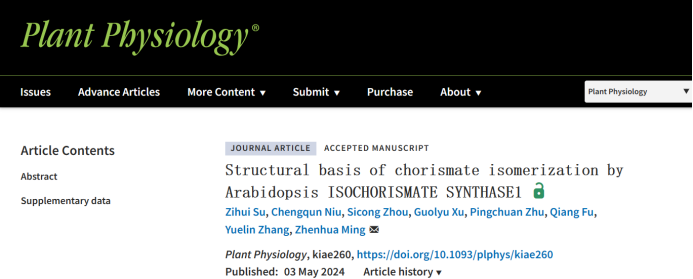Ming Zhenhua's research group revealed the catalytic mechanism of ICS1, a key enzyme in salicylic acid biosynthesis
Release time: 2024-05-06

The research group of Ming Zhenhua in our college published the research article titled "Structural basis of chorismate isomerization by Arabidopsis ISOCHORISMATE" in Plant Physiology, which revealed the structure and catalytic mechanism of isomerization of branched acid catalyzed by Arabidopsis isomeric acid synthase ICS1.
Through LC-RAM-MS experiments, it was found that the heteromeric acid synthase ICS1 of Arabidopsis, rice, soybean and tomato plants can catalyze the isomerization of substrate heteromeric acid to produce heteromeric acid. The activity of plant ICS1 was magnesium ion dependent.Arabidopsis thaliana had the highest ICS1 activity, rice had very low ICS1 activity, and tobacco had no ICS1 activity.
To elucidate the catalytic mechanism of plant ICS1 protein, the crystal structure of Arabidopsis ICS1 and its complex with substrate branched acid was analyzed. The key amino acid residues used by ICS1 for substrate recognition and catalysis were identified by structural analysis, and the enzyme activity experiments of mutants showed that these amino acids played an important role in the ICS1 catalysis process.
The researchers also found that there is a long channel between the catalytic center of the enzyme molecule and the solvent, and the substrate needs to overcome a high energy barrier to cross the channel to reach the active site. The results of molecular docking and mutant experiments show that there is a key site in the long channel that can bind the substrate, and the instantaneous binding of the substrate to this site can reduce the energy consumption of the substrate through the long channel, and ultimately improve the efficiency of entering the catalytic active site. Based on these findings, the researchers carried out rational design of rice ICS1 with low catalytic activity and successfully improved its catalytic activity.
Su Zihui, a PhD candidate in the School of Life Science and Technology of Guangxi University, is the first author of the paper, and Professor Ming Zhenhua is the corresponding author. Professor Yuelin Zhang from the University of British Columbia in Canada has made important contributions to the smooth development of the research work, and the Shanghai Synchrotron radiation light source has provided strong support for the diffraction data collection. The research work has been supported by the National Natural Science Foundation of China, the Guangxi Jieqing Foundation and the Guangxi "Ba Gui Scholars Program".
Paper link: https://doi.org/10.1093/plphys/kiae260